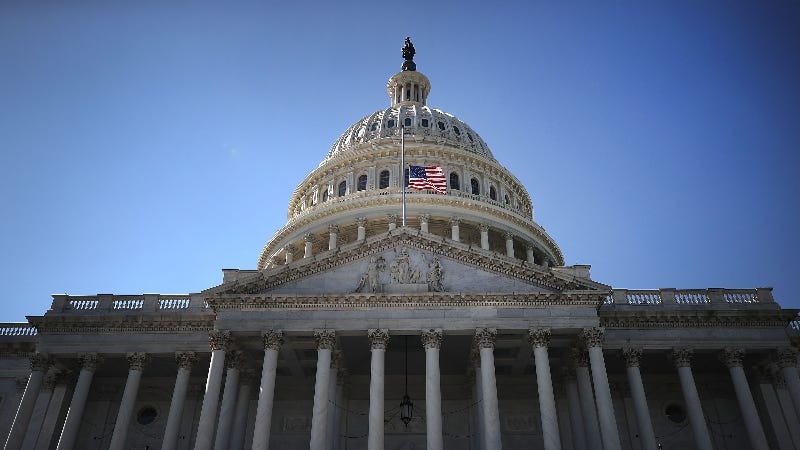How the SECURE Act impacts your retirement savings

The Bankrate promise
At Bankrate we strive to help you make smarter financial decisions. While we adhere to strict , this post may contain references to products from our partners. Here's an explanation for .
Saving for retirement and ensuring those funds last throughout your lifetime is now a little easier, thanks to a new bill passed by Congress.
The Setting Every Community Up for Retirement Enhancement (SECURE) Act, signed into law by President Donald Trump in Dec. 2019, aims to improve the nation’s retirement system. The bill’s 30 provisions provide Americans with new opportunities to save and strengthen their retirement security across the U.S., whether they’re three or 30 years away from leaving their working days behind.
“There is general agreement on both sides of the aisle that people need to be saving for retirement, and we want to create the incentives and vehicles for them to do so,” says Elizabeth Kelly, senior vice president at United Income who served as a special assistant to the president at the White House National Economic Council under the Obama administration. “More changes are needed to help make sure that all Americans are prepared to live a secure and dignified retirement, but the vast majority of the provisions are a step in the right direction.”
The SECURE Act’s passing means it’s now the biggest legislative change to the retirement system in more than a decade, when the Pension Protection Act was passed in 2006. Here’s a breakdown of the SECURE Act and how you can expect it to impact your retirement savings.
What is the SECURE Act, and why does it matter?
The reality surrounding retirement is bleak: A lot of Americans aren’t prepared.
More than half of American workers say they’re behind on their retirement contributions, according to a Nov. 2019 Bankrate survey. A separate Bankrate survey from May 2019 found that nearly one in five adults aren’t saving anything for when the day they ultimately leave the workforce.
Contributing to that bleak picture is an issue of accessibility, Kelly says. Thirty-three percent of private sector workers don’t have access to a retirement savings plan as of March 2019, according to the Bureau of Labor and Statistics.
Those numbers are even more grim for part-time workers and employees at small firms. Nearly 39 percent of individuals who work less than 35 hours each week have access to a 401(k) or pension plan at work, according to the Labor Department report, while 54 percent of workers at businesses with fewer than 100 employees had access to only a 401(k), according to BLS.
“We know that the best way to get people to save is to offer them a workplace retirement plan, and ideally, to automatically enroll them in that plan,” she says. “The goal [of the bill] is to give people the tools to be better prepared by increasing the availability of retirement savings plans.”
People are also living longer and working much later in their lives. The remaining provisions are “basically intended to update the rules to increase longevity” of individuals’ funds, Kelly says.
How the SECURE Act impacts retirement plans
Though there are 30 updates to the retirement system, here’s where you’ll see the most impact, according to retirement experts.
1. Includes part-time employees
Previous laws allowed employers to exclude their part-time employees from eligibility for a 401(k) plan. That won’t be the case, now that the SECURE Act is passed.
Under this legislation, your employer must allow you to participate in its defined contribution plan if you work at least 500 hours hours during three consecutive years.
This will help the growing number of baby boomers who seek part-time work instead of fully retiring, says Rhian Horgan, founder and CEO of Kindur, a retirement planning platform.
“The old world where you retire at [age] 62 or 65 and go from working full-time to retirement isn’t what modern retirement looks like,” Horgan says. “We see more and more retirees sliding into retirement.”
2. Raises age requirement for required minimum distributions
Previous law required that participants start withdrawing from their retirement savings accounts at age 70.5. The new bill raises that minimum age to 72. That’s intended to “ensure that individuals spend their retirement savings during their lifetime,” according to a House of Representatives statement that originally accompanied the bill.
“It’s basically saying that you don’t have to take your minimum distributions until age 72 instead of age 70.5,” says Gene Steuerle, institute fellow and Richard B. Fisher Chair at the Urban Institute. “People are living longer.”
The law also repealed the maximum age for contributing to a traditional IRA, also currently set at 70.5. Under the SECURE Act, you can now continue contributing to your retirement savings plan, as long as you’re working.
“As Americans live longer, an increasing number continue employment beyond traditional retirement age,” according to the bill.
3. New 10-year deadline on inherited 401(k)s or IRAs
The SECURE Act changes how long you can hold on to a 401(k), a traditional IRA or a Roth IRA that you’ve inherited from someone who’s died. Previous guidelines said you could stretch the balance out over your lifetime, but under the new bill, those balances must be withdrawn within 10 years.
But there are some exceptions. If you’re an individual with a chronic disability or illness, as well as a surviving spouse or minor child of the account owner, you would not be subject to these new regulations.
“It’s both to raise money to pay for the provisions of the bill that may cost some money by virtue of increased savings being tax deferred, but also to make sure that the 401(k) plans and IRAs, are not being used indefinitely as a tax-deferred vehicle by the inheritors,” Kelly says.
4. Allows annuities to be offered in 401(k) plans
Annuities are an investment that provides regular disbursements throughout a period of time in exchange for an upfront, lump-sum payment. Essentially, they act as a fixed and steady stream of income during your retirement and can help prevent outliving your savings. Most 401(k) plans, however, don’t offer the option to purchase annuities – but that could change.
The bill creates a safe harbor for employers, making them more likely to offer these plans.
“It’s a recognition that we are living longer. Consumers today have to manage the drawdown of their assets,” Horgan says. “This move from pensions to 401(k)s is creating a tremendous amount of liability and responsibility for consumers.”
But don’t expect that to happen all at once, says Shai Akabas, director of economic policy at the Bipartisan Policy Center. Employers will most likely roll out those plans gradually.
“I don’t think that people are waiting to hit the ‘go’ button and will start offering them tomorrow,” Akabas says. “Over time, you’ll see additional employers considering this option. I would guess that it would be over several years.”
5. Permits multi-employer 401(k) plans for small businesses
Opening up a work-based retirement savings plan such as a 401(k) can be costly for small businesses. As a result, many firms choose not to offer them, forcing employees to find savings plans on their own. A provision in the SECURE Act, however, seeks to change that.
The bill expands employers’ abilities to offer multi-employer plans, as long as they have the same trustee, fiduciary, administrator, plan year and investment options, “making it easier for small employers to sponsor a retirement plan and thus improving retirement savings,” according to the Ways and Means Committee.
The bill also offers tax credits of $500 intended to “defray startup costs” for new 401(k) and simple IRA plans that include automatic enrollment.
“Basically, the idea is that you enable small businesses to band together and create one large retirement plan with the goal of lowering the administrative burden on each plan’s sponsor and costs,” Kelly says.
6. Requires 401(k) statements to include lifetime income stream disclosure
For those between the ages of 30 and 39, you should have about $66,000 in your retirement savings, according to a Bankrate analysis of Labor Department data. That may seem like a lot, but if you’re trying to stretch it out over your lifetime into a monthly or even weekly stream of income income, it may seem like a different story.
The new retirement bill requires benefit statements to include a disclosure illustrating “monthly payments the participant would receive if the total account balance were used to provide lifetime income streams,” according to text accompanying the bill.
This could help you learn what still needs to be done regarding your retirement savings – and whether you should be contributing even more.
How the bill may change the way you save
Outside of the retirement space, the SECURE Act provides extra opportunities to save elsewhere, by increasing your flexibility in covering costs associated with education and adoption.
“People are increasingly viewing retirement security as a more holistic problem and a comprehensive financial security challenge,” Akabas says. “People are recognizing the fact that student loans and health care issues play into the picture of the retirement broader narrative. It’s fair to look at these provisions as going hand-in-hand with some of the more direct retirement provisions.”
1. Expands 529 account flexibility
The SECURE Act also expands the uses for 529 accounts, an investment vehicle that helps individuals save for higher education costs. The bill allows individuals to use funds within these accounts for apprenticeships and qualified student loan repayments loans of up to $10,000, according to the bill.
“Creating more flexibility on 529s overall incentivizes savings and increases flexibility,” Horgan says. “Flexibility means that you’re more likely to try to save. When things are inflexible, you’re less likely.”
2. Allows adoption or child birth cost withdrawals
The bill allows individuals to withdraw up to $5,000 penalty-free from their retirement accounts to cover qualified costs associated with a new birth or adoption, as long as that distribution is made within a year. That means a couple could take up to $10,000 out penalty-free, granted they each have a separate retirement account.
Taxes still will need to be paid on pre-tax contributions, and you’ll still want to carefully consider whether a withdrawal is worth it if it means excluding funds from decades worth of compound growth on your investments. But the good news is: You won’t have to pay an early-withdrawal penalty fee.
Where the SECURE Act falls short
The nature of accounts such as 401(k)s and IRAs is that they’re self-directed; the account owner must be the one who chooses the investment strategy. But statistics don’t paint an overall rosy picture for that readiness: A June 2018 Bankrate survey found that 61 percent of Americans don’t know how much they will need to have saved to fund their retirement.
Meanwhile, six in 10 non-retirees who hold these self-directed retirement savings accounts have little to no comfort in managing their investments, according to the Fed’s household well-being survey.
“People need more choices, but it always then raises an extra challenge,” says Jeff Yastine, senior equities analyst at Banyan Hill who helps people invest for retirement. “People already feel overwhelmed by their choices when it comes to 401(k)s. (The bill) makes it more complicated for all of us to know and make the right choice.”
The bill also doesn’t address other issues surrounding retirement, such as rising health care costs and Social Security insolvency, though it could protect people from those problems indirectly, Kelly says.
“There are certainly bigger issues in retirement that need to be tackled outside” of the bill, she says. “To the extent the bill encourages more people to save, so that they have more money to cover future health care costs, more is better.”
Bottom line
It’s a good time to review your current plan and find a strategy to increase your contributions, Horgan says.
“If you’re under the age of 70.5 and working part time and haven’t participated in a plan, that’s encouraged for people in their 50s and 60s,” Horgan says. “It’s an opportunity to review your plan to create an income in the transition period.”
If you’re one of these people to which benefits are now being extended, be sure to reach out to your plan provider about how you can enroll.
And because the legislation creates so many new options for retirement savings, it increases the importance of educating yourself on all of the options at your disposal, so you can choose the plan that’s right for you, Yastine says.
“That’s the curse of having a choice,” Yastine says. “If you don’t have a choice, it’s taken completely out of your hands. If you have three [to] five different choices, now the potential for confusion and misunderstandings grows exponentially. On the other hand, if you make better choices and you can get educated, you will have a better retirement than you might have had otherwise.”
Learn more:
Related Articles




10 of the biggest changes to retirement accounts due to new 401(k) and IRA rules